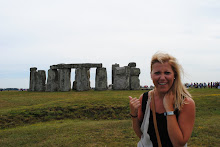Side Note: Working nights is nice. I get to sleep in and do a lot of things I wouldn't be able to otherwise. But it's not good for going anywhere, especially different cities, after 8 pm. That is why Alix and I chose to do a tour of the DMZ on a Sunday, so we could take our time arriving in Seoul the day before. Because of this, our tour was somewhat limited. We still got to see a lot but we didn't get to visit the JSA- joint security area. According to Wikipedia, this is the "truce village," where North and South Korean soldiers face each other and engage in "peace talks." I believe this is where you can actually step into North Korea and get a view of the propaganda village. It would have been incredibly interesting to see this and I'm a little disappointed I didn't get the chance. But to be perfectly honest, the entire situation weighs heavy on my heart. I think I would have been overwhelmed, and truthfully scared, to go there.
Our first stop on this particular tour was Imjingak. According to this helpful website, it was built in 1972 in the hopes that the two Koreas would reunite. There are several monuments, a park and various artifacts from the war on display here. There is also a Freedom Bridge which South Koreans crossed when they entered from the North for the first time after the war "ended."
From here, we went to visit the Third Tunnel. According to Wiki, it "is a tunnel under the border between North Korea and South Korea. It was the third tunnel to be discovered running under the border between the two Koreas." The tunnel was discovered in 1978 and was, as the name indicates, the third out of four tunnels that were found. As I understood it, some believe there are as many as 20 tunnels that were dug that have yet to be discovered. Amusingly enough, "Initially, North Korea denied building the tunnel then officially declared it part of a coal mine; black "coal" was painted on the walls by retreating soldiers to help confirm this statement."
We got to walk through the tunnels wearing goofy helmets (which I did not regret wearing whatsoever when I hit my head numerous times on the ceiling). It was interesting to walk through, imagining that hundreds of soldiers could have possibly taken the same path into South Korea with the intentions to do harm. We weren't allowed pictures of the tunnel and I was clearly not going to press my luck, so you can imagine; it was dark, damp and small.
After the tunnel, we went to the Dora Observatory where it was possible to look into North Korea. It was a bit smoggy that day and there was a photo line we were forbidden to cross, so I don't have much proof of this, either.
It was so fascinating. From here, it's possible to see the border and the two gigantic flags representing each country that fly alarmingly close to each other. A realistic slap in the face that these two countries (once the same) are still, technically, at war.
We ended the tour at Dorasan train station. If I remember correctly, this was made entirely from donations. Wikipedia didn't give much information on the station itself, but as of now, it's waiting to be put into use. It actually broke my heart to see how abandoned it was. Besides the few other tour groups, it was ghostly.
We were able to get "stamps" into North Korea here. We were told not to put them in our passports but we didn't give that advice much consideration. If nothing else, it will make for a nice conversation starter in an airport. We also bought "tickets" to Pyeongyang, the capital of North Korea. What a bargain, only 1,000 won! I made the remark that the man working at the counter was just playing make-believe, which in many ways he was. He sold us our ticket and gave us our stamp but it was all just one big game of pretend.
If the North and South ever do reunite, it would be possible to take a train from Busan all the way to London. Gives me goosebumps just thinking about it, uniting countries, continents, citizens all over the world. There just isn't enough of that these days.
Overall, it was a great experience and I was glad I did it. I knew that I wanted to visit the DMZ during my time here but it was also heartbreaking. I have grown to love and admire Korea in more ways than I could explain and I've been in denial about the situation the country is in. It was a harsh reminder that this may go on forever. Truth be told, it was bizarre that something representing so much pain and turmoil has been turned into a tourist trap. There were gift shops at each stop selling everything from DMZ puzzles to bath towels. I believe it's important to try and understand what's going on but at what point does it become too much? It seems that it would almost be too much of a hassle to reunite at this point. What will they do with all the souvenir barbed wire plaques?!
All jokes aside, it was a sobering experience. Seeing all the young soldiers, trying to imagine day to day life, it was impossible to try and understand what they have to endure. All I could imagine were my young male students having to stand guard over the border one day. A harsh reminder that wars, and this war in particular, will continue to affect families for generations to come.


















